AICE Bio Unit 7- Transport in Plants
Major plant organs:
roots
stems
leaves
Types of tissue:
Dermal tissue
Ground tissue
Vascular tissue
DERMAL tissue:
epidermis of the plant.
above ground (aerial) parts secrete a waxy cuticle.
STOMATA: pores that allow for gas exchange
Periderm: bark (specialized epidermis)
ENDODERMIS: inner layer separating the tissue layer
GROUND tissue:
structural support and storage
3 types
PARENCHYMA: thin & flexible walls. most common
Collenchyma: flexible support
Schlerenchyma: cell walls with lignin
* VASCULAR TISSUE:
vessels that connect the organs
2 types:
XYLEM: carry water & minerals from the soil to the rest of the plant. (only up)
PHLOEM: Carry organic materials (food- sugar and proteins, “assimilates”) around the plant (up or down)
show up in vascular bundles
MONOCOT VS DICOTS:
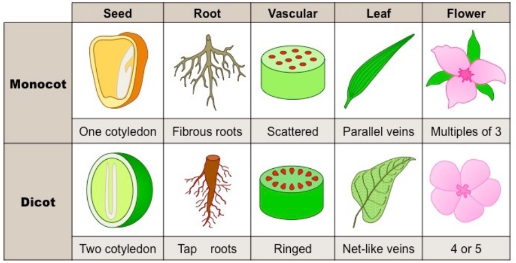 ROOTS:
ROOTS:
epidermis, ground tissue (cortex), stele (vascular bundle), casparian strip, (waxy band along endodermis)
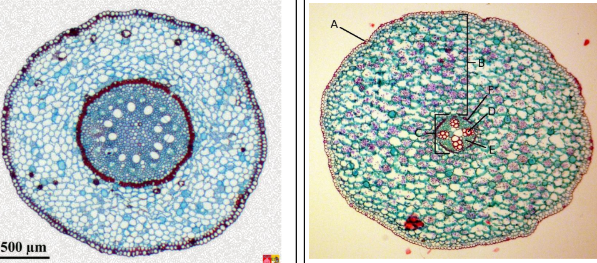
MONOCOT (left): ringed vasuclar in center
DICOT (right): cross-shaped vascular in center, no pith
STEMS
epidermis, ground tissue, vascular bundles.
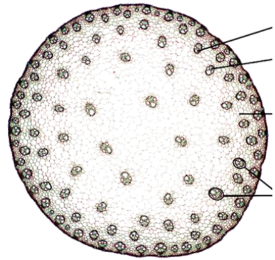
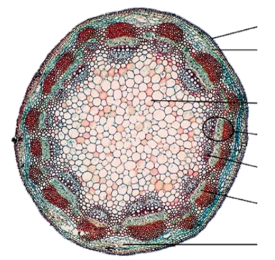
MONOCOT (top): only cortex, vascular bundles are scattered & look like faces
DICOT (bottom): cortex and pith, vascular bundles are in a ring, cortex outside bundles and pith in the middle
LEAVES:
epidermis, cuticle, stomata, mesophyll (ground tissue directly below epidermis)
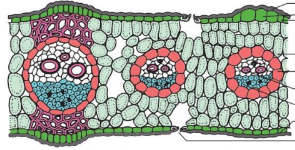
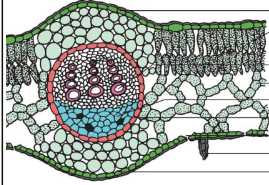
MONOCOT (top): n/a
DICOT (bottom): clear division between palisade mesophyll/parenchyma and the spongey parenchyma/mesophyll
XYLEM:
water transport (and minerals in water)
uptake starts with the root hair cells
water moves through the root cortex into the xylem, up the xylem (high and low water potential), and to the leaf, where it is lost through stomata.
high water potential in roots, low in leaves
dead cells at maturity
LIGNIN- strong, waterproof material
Apoplast pathway: water enters and moves through cell walls (intercellular spaces)
Symplast pathway: water enter the cytoplasm and moves via plasmodesmata
Casparian strip: made of suberin, found on the wall of the endodermis in roots, stops the apoplast pathway. After Casparian strip, water only travels by the symplast
PHLOEM:
transports sugars mainly
pores separate sieve tube elements and sieve platess
cells are ALIVE
lack organelles
companion cells: perform vital functions that sieve members can’t, made of modified parenchyma cells, dense cytoplasm and small vacuoles
translocation: movement in the phloem
transport of manufactured substances via mass flow
source-to-sink: source is anywhere sugar is produced (leaves) or stored, and sink is anywhere the sugar is needed
water follows solutes, so a hydrostatic gradient forms when water leaves the phloem as well.
sucrose: made by mesophyll cells in the leaves during photosynthesis
sucrose leaves the phloem by diffusion, and then is broken down by invertase
most water goes through this pathway: root hairs, cortex, xylem, mesophyll, stomata.
STOMATA:
pores at the surface of leaves, open and close to regulate water intake and loss.
transpiration: the loss of water vapor from the leaves by evaporation
transpiration pull: the idea the evaporation from the leave drives the concentration gradient (by pulling water up)
water will escape via transporation inevitably.
Xerophytes:
plants that posses physical modifcations to their structure to reduce water loss
Not CAM or C4 plants!
adaptations:
smaller leaves (smaller surface area)
thicker cuticle
waxy/powdery deposits on the leaves
less stomata, stomata concentrated on the bottom of the leaves, and sunken stomata
rolled leaves
epidermal hairs to trap moisture around stomata